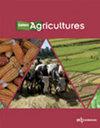油棕种植对墨西哥土壤有机碳储量的影响:来自塔巴斯科州种植园的证据
IF 1.1
4区 农林科学
Q3 AGRICULTURE, MULTIDISCIPLINARY
引用次数: 0
摘要
需要对油棕种植园对墨西哥土壤有机碳储量的影响以及这些农业系统提供的环境服务进行更多的研究。本研究重点估算了油棕人工林内3个区域(棕榈圈、棕榈叶下和棕榈行之间)、3个土壤深度(20、40和60 cm)的土壤有机碳储量,并比较了不同土地利用方式(20年牧场(GS20)、20年油棕人工林(OP20)和20年次生林(SF20)的土壤有机碳储量。结果表明,油棕种植时,土壤有机碳主要储存在叶面区域,棕榈圈的固碳量较低。在20 cm和60 cm土层,碳储量分别为87 Mg C ha - 1和67 Mg C ha - 1。在土地利用比较方面,结果表明,牧场和棕榈林的碳储量在20 cm深度增加27%,在60 cm深度增加18%(无统计学意义)。次生林的碳储量高于其他两种土地利用方式。本文章由计算机程序翻译,如有差异,请以英文原文为准。
Impacts of oil palm cultivation on soil organic carbon stocks in Mexico: evidence from plantations in Tabasco State
There is a need for more studies on the effects of oil palm plantations on soil organic carbon storage and on the environmental services provided by these agrosystems in Mexico. This study focused on estimating the soil organic carbon stocks in three areas within oil palm plantations (palm circle, under the frond and between palm rows), at three soil depths (20, 40 and 60 cm) and comparing the carbon storage between different land-uses: a 20-year-old pasture (GS20), a 20-year-old oil palm plantation (OP20), and a secondary forest (SF20). Our results suggest that oil palm plantations store soil organic carbon mainly under frond areas when sown in lixisols and luvisols, with lower carbon sequestration in the palm circle. Regarding the soil depth, the estimated carbon storage was 87 Mg C ha−1 and 67 Mg C ha−1 at depths of 20 and 60 cm, respectively. Regarding land-use comparison, results indicate an increase (not statistically significant) in carbon storage to 27% at 20 cm depth and 18% at 60 cm between pasture and palm plantation. The second-growth forest presented higher carbon storage compared to both other land uses.
求助全文
通过发布文献求助,成功后即可免费获取论文全文。
去求助
来源期刊

Cahiers Agricultures
农林科学-农业综合
CiteScore
2.00
自引率
22.20%
发文量
23
审稿时长
3 months
期刊介绍:
Cahiers Agricultures is a - mainly - French language scientific journal on world farming systems, how they are changing and their role in society. It is aimed at all those – researchers, field workers, teachers – who are interested in a holistic reflection on the agricultural world.
Cahiers Agricultures gives priority to research on agriculture as implemented by farmers, that has meaning for citizens in countries in the North and South, as opposed to research work conducted in a controlled environment (laboratory, research center, etc.). Research of this type is often multidisciplinary and takes into account the knowledge and know-how of the different stakeholders. The different parties are also actively involved in research, alongside the scientists. In this way, the journal stimulates debate on issues linked to society, such as the impact of using water and nitrogen fertilisers, peri-urban farming, fish farming, livestock production in rural areas, food security, etc.
 求助内容:
求助内容: 应助结果提醒方式:
应助结果提醒方式:


